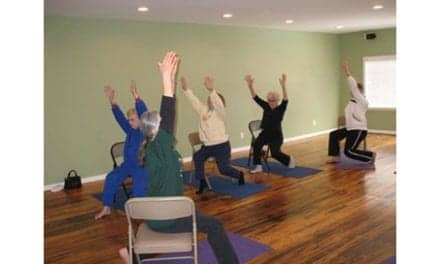PHOTO CAPTION: The author teaches online classes from her home. Now, more hybrid programs are available to offer students the opportunity to participate in virtual classroom content from home and visit campus several days each semester for hands-on content.
The COVID-19 pandemic pushed academia into the 21st century.
By Kirsten Davin, OTD, OTR/L, ATP, SMS
Colleges and universities around the globe have traditionally demonstrated hesitance in shifting to a more technologically advanced, digitally driven curriculum, despite industries outside of academia embracing a tech-based approach to business. According to the US Department of Education, prior to the beginning of the coronavirus (SARS-CoV-2) pandemic in March of 2020, over two-thirds of college students had not enrolled in an online course or participated in any type of virtual, hybrid, or blended learning. This was especially true for healthcare programs, such as physical and occupational therapy, PT and OT assistant programs, nursing, and other healthcare-based programs of study. Since the conception of higher-level academia, little had changed in the provision of healthcare pedagogy as instruction was face-to-face, and the development of clinical skills involved hands-on practice within a traditional brick-and-mortar setting.
The frantic and sudden shift to online learning due to the COVID-19 outbreak in Spring 2020 offered an unprecedented challenge to many in higher education. Within a matter of days, traditional brick-and-mortar courses, labs, and lesson plans which required on-site attendance and hands-on participation had to transition to an online mode of course provision. Colleges and universities that demonstrated previous reluctance to change had no choice but to transition to some form of remote learning format.
Benefits of Online Education
Although in many cases the transition to online education in healthcare was reluctant and quick, often consisting of a cursory video chat in place of a lecture, as further exploration of the various platforms and methods of virtual instruction occurred, significant benefits to online or virtual education were discovered.
Recent progress in technology has eased the provision of remote education. Despite the various terms used for online learning, such as virtual learning or web-based learning, the common thread is the same. The dissemination of knowledge via a virtual platform offers the learner the ability to acquire knowledge from any location, at any time. In an online or virtual environment, the student has the opportunity to perform autonomous tasks and classroom activities such as voice-over lectures and independent guided learning exercises which may correlate with textbook readings or additional web resources.
The flexibility that accompanies an online course and, in some cases, virtual curricular design has opened a multitude of doors for second-career students, those with young families, and students with other responsibilities outside of school. In addition to greater flexibility, many virtual platforms offer the ability for a greater degree of student-centeredness, immediate feedback, and continued monitoring of student progression. In educational programs that traditionally utilize human cadavers for dissection, some healthcare programs have initiated the use of virtual dissector software for labs. While offering real-time, true-to-life results from the student’s dissection actions, virtual dissection software ensures the opportunity for repetition of skills, replay of process, and, in some cases, advanced assessment of learning that traditional use of cadaver could not.
Synchronous vs Asynchronous Learning
Two types of course provision exist with the virtual learning arena: synchronous learning and asynchronous learning. Within a synchronous learning platform, students use a teleconference platform (ie, Zoom, Microsoft Teams, etc) to participate in real-time audio/video sessions hosted by the course instructor, where real-time feedback and input can be shared, much like in a traditional classroom setting. Typically, a set class time is implemented by the instructor, and class sessions may include live discussion and break-out teleconference rooms where students may work together in smaller groups to formulate responses to questions posed by the instructor or hold dialogue regarding case studies that have been presented. Social interaction and the process of building rapport among students and between students and faculty is most easily acquired via this type of learning platform.
An asynchronous learning platform allows the flexibility previously referenced, via the use of voice-over lectures, required readings, and supplemental web-based resources. Students may complete tasks often at their leisure, yet within a structured time frame.
Hybrid or Blended Education
One challenge frequently experienced when considering online education in a healthcare setting is the need for the healthcare student to experience, practice, and demonstrate certain hands-on skills during coursework and throughout the curriculum.
Hybrid, otherwise known as blended education, consists of virtual components, such as learning modules within a web-based learning management system (ie, Canvas or Blackboard) as well as hands-on components (ie, hands-on lab experiences). This combination is especially important and frequently used in educational programs related to healthcare, where clinical skills and competencies need to be met.
Hybrid or blended learning is quite beneficial to online physical or occupational therapy programs where hands-on skills including patient transfers, assessment, evaluation, and gait or activities of daily living intervention must be performed and assessed by faculty to determine competency. A hybrid or blended format may allow the student to acquire the basic knowledge (ie, physics of transfer, introduction to patient safety, etc) via a virtual format, then arrive to campus for hands-on lab immersions, which may include the physical practice of transferring a patient, role-playing for purposes of patient assessment, and more.
Challenges of Online Education
A number of technologies for online education are available, but sometimes, as occurs from time to time with technology, challenges may ensue ranging from Internet connection difficulties or bandwidth issues as they pertain to streaming live synchronous sessions or viewing pre-recorded lectures. Teleconference platforms and learning management systems that are novel or new to students are often the source of student anxiety as the new technology is explored and as students become accustomed to its use.
Although a perceived challenge to online education may be related to the student’s need for personal, one-on-one attention, interaction with faculty or classmates, and a sense of community, recent technology has minimized this challenge as many online platforms allow for virtual face-to-face engagement and promote discussion in a virtual format. FlipGrid is a virtual platform that allows students to post video responses to a question posed by the course instructor. Students may respond initially to the question posed, while others, including faculty, may respond to the initial post from a classmate. While housed in the foundation of the discussion boards of the previous generation of online learning, audio-video platforms such as FlipGrid allow the student improved interaction and promotion of community.
Anyone who has served in an instructor role understands the effort and preparation which must be included in course development to ensure student engagement. This age-old challenge was perceived to be difficult enough when in the same classroom, aside from the additional challenges related to student engagement in a virtual environment. Fortunately, interactive platforms such as Padlet, Kahoot, and others have unlocked a world of interactive opportunities.
The Padlet platform is a bulletin board of sorts, where students may post website links, images, video and other sources of multimedia to be shared with others, who may provide feedback and response. Kahoot is one of the many interactive game-based quiz and polling platforms which, through the use of cell phone technology and text messaging, allows students to submit answers to questions posed by faculty. Results may be shared in real time within the virtual classroom.
One ongoing challenge presented by online education is the degree of dedication and self-regulation required of the student. When students are not required to physically attend a course, they may be tempted to simply view the day’s synchronous session after class. This tends to open the door to a potential for lack of participation on behalf of the student.
Work-life balance can be challenging in a virtual environment. The computer can easily be turned off in light of external distractions including work, family, or other obligations. In an effort to circumvent external distraction and encourage students to routinely return to the learning management system to participate in the course on, ideally, a daily basis, it is often advisable to incorporate multiple smaller due dates and requirements for students to check in and participate in class throughout each module.
The Future of Online Education
While the COVID-19 pandemic launched a widespread transition to online education in the college and university settings, it successfully opened doors to the future of online education, for not only traditional lecture-based courses, but for courses with lab and interactive, hands-on requirements as well.
The initial transition also shined a light on many existing programs that were already immersed in online, hybrid, or blended learning. New, cutting-edge physical and occupational therapy programs have adopted a hybrid design and are now offering students the opportunity to participate in virtual classroom content from home and visit campus for several days each semester to learn, practice, and be assessed on hands-on content. The future of online education is here and will likely result in greater inclusivity for students and an unprecedented flexibility in learning, welcoming those who have challenging schedules or circumstances perhaps not conducive to a traditional classroom learning, and embracing the technologically fluent student who wishes to take a virtual approach to education.
A comprehensive list of physical and occupational therapy programs, including those incorporating a hybrid curriculum, may be viewed via the links below:
Current and developing OT programs via ACOTE website: www.acoteonline.org/schools/ot-doctorate/
Current and developing PT programs via CAPTE website: www.capteonline.org/Programs/. RM
Kirsten Davin, OTD, OTR/L, ATP, SMS, an occupational therapist of nearly 20 years and expert in the seating/positioning industry, currently serves as a clinical assistant professor and academic fieldwork coordinator for Baylor University’s OT Doctorate Program. For more information, contact [email protected].




